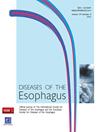297.评估接受新辅助化放疗的食管癌患者的血液生物标志物
IF 2.3
3区 医学
Q3 GASTROENTEROLOGY & HEPATOLOGY
引用次数: 0
摘要
背景 食管癌是全球第六大常见的癌症致死原因。尽管采用了多模式治疗方法,但食道癌的死亡率仍然很高。新辅助化放疗是标准的治疗方法,但临床上需要新的疗法。HER2靶向疗法和针对PD-1/PD-L1轴的免疫检查点抑制剂已成为近年来备受关注的治疗策略。本研究旨在探索潜在的基于血浆的生物标记物(生长因子、细胞因子、可溶性(s)PD-L1),研究对象为接受标准护理新辅助疗法的食管癌患者(pts),并根据 HER2 表达和病理完全反应(pCR)进行分层。方法:招募 50 名符合新辅助治疗条件的食道癌患者。分别在治疗前、第二周期第一天和新辅助治疗后采集血样。血浆在抽血后四小时内提取,并储存在-800C。本分析包括 20 份治疗前和治疗后的匹配样本。17例患者的HER2状态(IHC 3+ (n=3), IHC 2+ (n=5), IHC 1+ (n=3), IHC 0 (n=6))。3例患者获得了pCR,但没有HER2 IHC数据。使用人类生长因子 Luminex Performance Assay 和 Luminex MagPix 系统评估了 21 种分析物的水平(pg/ml)。如果p<0.05,经配对学生t检验,则变化有意义。结果 最终分析评估了 21 种反应生物标志物。血小板衍生生长因子(PDGF)-AA 和 PDGF AA/BB 在受测分析物中的浓度水平最高,但治疗前后的浓度水平没有变化。GRO-b(CXCL2)和血管内皮生长因子(VEGF)在治疗后出现了数值上的增加,但并不显著(p<0.05)。肿瘤坏死因子相关凋亡诱导配体(TRAIL)蛋白在治疗后显著下降(p=0.038)。PD-L1水平在治疗后周期明显升高(配对t检验 p=0.0029),尤其是在HER2+患者中。根据HER2 IHC或pCR状态分类,TRAIL或sPD-L1水平无明显差异。结论 新辅助治疗后,食管癌患者外周血中 sPD-L1 水平升高,TRAIL 水平降低,这表明治疗改变了与免疫抑制和诱导肿瘤细胞死亡相关的因素。有必要在更大的群体中开展进一步研究。本文章由计算机程序翻译,如有差异,请以英文原文为准。
297. ASSESSING BLOOD-BASED BIOMARKERS IN OESOPHAGEAL CANCER PATIENTS RECEIVING NEOADJUVANT CHEMORADIOTHERAPY
Background Oesophageal cancer is the sixth most common cause of cancer-related deaths globally. It has a significant rate of mortality despite the multimodal approach to treatment. Neo-adjuvant chemoradiotherapy is standard of care but there is a clinical need for new therapies. HER2-targeted therapies and immune checkpoint inhibitors targeting the PD-1/PD-L1 axis have emerged as treatment strategies of significant interest in recent years. This study focuses on exploring potential plasma-based biomarkers (growth factors, cytokines, soluble (s) PD-L1) in patients (pts) with oesophageal cancer receiving standard of care neo-adjuvant therapy and stratified based on HER2 expression and pathological complete response (pCR). Methods 50 pts with oesophageal cancer who are eligible for neoadjuvant therapy were recruited. Blood samples were taken pre-treatment, on the first day of the 2nd cycle and post-neoadjuvant treatment. Plasma was extracted within four hours of blood draw and stored at -800C. 20 matched pre- and post-treatment samples were included in this analysis. HER2 status (IHC 3+ (n=3), IHC 2+ (n=5), IHC 1+ (n=3), IHC 0 (n=6) was available for 17 pts. 3 pts achieved a pCR but no HER2 IHC data was available. The levels (pg/ml) of 21 analytes were assessed using the Human Growth Factor Luminex Performance Assay and a Luminex MagPix system. Changes were significant if p<0.05, paired student’s t test. Results Twenty-one biomarkers of response were assessed in the final analysis. Platelet-derived growth factor (PDGF)-AA and PDGF AA/BB displayed the highest concentration levels of the tested analytes but levels did not change pre-and post-treatment. GRO-b (CXCL2) and vascular endothelial growth factor (VEGF) displayed a numerical increase post-treatment but this did not prove significant (p<0.05). Tumour-necrosis factor-related apoptosis-inducing ligand (TRAIL) protein decreased significantly post-therapy (p=0.038). PD-L1 levels significantly increased in the post-treatment cycles (paired t-test p=0.0029), especially in pts with HER2+ status. TRAIL or sPD-L1 levels were not significantly different when categorised by HER2 IHC or pCR status. Conclusion The increase in sPD-L1 and reduction in TRAIL levels in the peripheral blood of oesophageal cancer patients following neoadjuvant therapy suggests treatment alters factors associated with immune-suppression and the induction of tumour cell death. Further investigation in a larger cohort is warranted.
求助全文
通过发布文献求助,成功后即可免费获取论文全文。
去求助
来源期刊

Diseases of the Esophagus
医学-胃肠肝病学
CiteScore
5.30
自引率
7.70%
发文量
568
审稿时长
6 months
期刊介绍:
Diseases of the Esophagus covers all aspects of the esophagus - etiology, investigation and diagnosis, and both medical and surgical treatment.
 求助内容:
求助内容: 应助结果提醒方式:
应助结果提醒方式:


